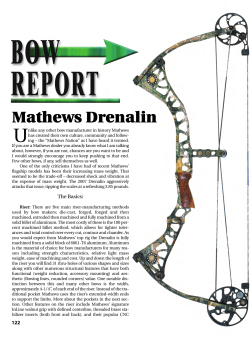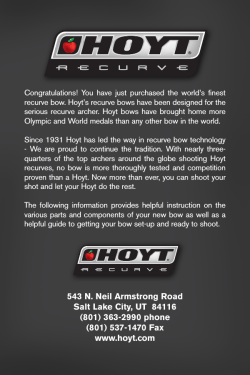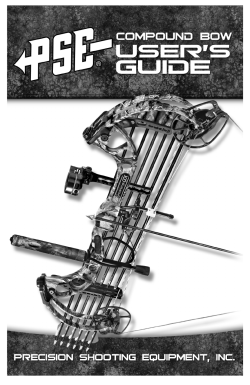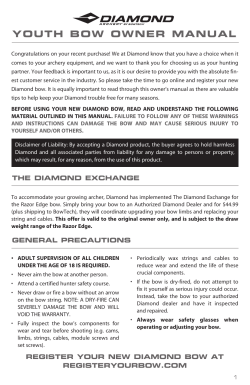
OUT ON A LIMB P Andrew Smith has some tips
Bow set-up Limb alignment OUT ON A LIMB Andrew Smith has some tips on how to straighten out your recurve limbs P erhaps the most common error in recurve set-up is limb alignment; this is unsurprising given the contradictory statements which are published and talked about at all levels of the sport. Misinformation only serves to confuse the issue further, especially for those new to archery or about to buy their first international limb fit bow (ILF). Firstly, to remove some misconceptions, most risers are not factory set, straight or otherwise. Some of the higher-quality manufacturers do check this as part of their quality control procedure and a couple go one step further, for example Stylist, which does not incorporate alignment adjustment on its riser at all; this means that all its risers are manufactured to a tight tolerance. But generally you will find that most risers arrive at Pro Shops as they come off the production line and in some cases the limb bolts may even be loose. Manufacturing process No manufacturer produces, or claims to produce, a completely straight handle, regardless of the type of materials or the process used. The way risers are made (either Casting, Forged, CNC or Carbon Fibre), the materials used to make these handles and the need for them to be affordable mean that it’s unusual to find a perfectly setup bow with the string running directly through the exact centre of both limb bolts or the handle. In some manufacturing processes the limb bolt holes are drilled after the handle has been produced, using a very accurate jig to ensure that all the fixings are straight. Finally, finishes on handles and limbs can also leave surfaces uneven, making them unreliable as reference points. Fig 1 If panic is setting in at this point and you’re thinking you’ll never shoot well with an imperfect set-up, don’t worry. Even the best archers have admitted to shooting world records and winning Olympic gold medals with moderately twisted risers. Limbs are a different animal, though. If your limbs are twisted it might be possible to straighten them so long as the bow has been used very little and the twist has not become permanent; failing this, the limbs will need to be replaced. The process used to check limb alignment is very simple. In the past it was only used to make sure that the limb tips didn’t become twisted during the stringing process. These days the check is more important because of the nature of ILF. In the past the handle and limbs were generic to the manufacturer, the Bowyer had complete control over the design and the limbs were manufactured to fit the handle. The limbs were also bolted to the handle and any additional limb adjustment was rare or redundant if the bow was manufactured correctly. Limb position In this respect a modern target takedown recurve bow is no different from one made 25 years ago and the basic principle remains the same – two springs held apart by a stiff piece of material. If set up correctly the limb tips on a takedown should travel forwards together in a straight line. More importantly you need to ensure that the limb tips unroll and travel back in this vertical plane. Most set up instructions today concentrate on the back of the limb and never reference the position of the limb tips. This is unhelpful because concentrating solely In some manufacturing processes the limb bolt holes are drilled after the handle has been produced, using a very accurate jig to ensure that all the fixings are straight, but this can mean the holes are slightly off-centre BOW INTERNATIONAL 35 35-36 Andrew Smith_Rev3.indd 35 28/11/08 18:49:34 Bow set-up on the back of the limb to get the string running through the centre of the limbs and handle can result in the limb tips becoming misaligned. Prolonged use like this can eventually put a permanent twist in one or both limbs. Set up tips Firstly, string the bow. Make sure that the limbs are properly seated. It’s best to either push the limbs home or draw the string back an inch or two and let go, sometimes you will hear a click, which will sound much louder if you do it when shooting your first arrow. Hold the bow as shown in Fig 1 on the previous page, looking straight down the string. Now glance down at the limb tip or preferably the shoulders of the limb where the string ‘V’ is (sometimes the actual tip, which is hand finished is not 100% symmetrical). This should sit in the middle of the limb; if it is to the left or right then it will need adjusting. Before making the adjustment turn the bow around and do the same check on the other limb, it may or may not need adjusting. Once you have made the necessary adjustments, moving the top and bottom limbs left or right to get the limb central, both limbs should look as in Fig 2 and the bow should be straight. You will find that the limb tips are now pointing in the same direction and the string runs through the centre of each limb. However it may not run directly through the centre of the limb bolts. It can take a bit of time to perfect this technique but given that it is possible to twist a limb tip in the process of stringing a bow it is also worth doing this check each time you set up the bow. You shouldn’t have to make any major adjustments, possibly just moving the limb tip a millimetre left or right. This check will also ensure that the adjustment screws have not come loose, causing the adjustment to move. If you have trouble identifying the centre of the limb then you can use the new Beiter X-Ruler to accurately mark this position. No manufacturer produces or claims to produce a completely straight handle, regardless of the type of materials or the process used Limb alignment Don’t worry. Even the best archers have admitted to shooting world records and winning Olympic gold medals with moderately twisted risers Limb tip off-centre requiring riser pocket adjustment Straight limb tip Fig 2 Finally, with any bow set-up or bow tuning you need to allow for human error. Having the limb tip slightly off-centre is not the end of the world and at least you will have a bow working with you not against you. Critics of the adjustment method I have just described claim that in doing the adjustments with the bow already strung it’s possible to straighten out a twist by twisting the limb back as you move it. In practice, however, drawing back the bow once you have made the adjustment will settle the string and limbs and a re-check will see if this has happened and then the necessary adjustment can be made. (You have to adjust Hoyts without the bow strung). The other comment is that the loops of a string can put a twist in the limb. In answer to this, poorly-made strings and loops are a hindrance, no matter what system you use. The advantage of adopting this set up is that you will always have a straight bow regardless of limb and riser quality. Top: Although the tips are centred the string may not run through the centre of the bolts Left: The Beiter X Ruler can help you identify the centre of the limb 36 BOW INTERNATIONAL 35-36 Andrew Smith_Rev3.indd 36 28/11/08 18:49:40
© Copyright 2025





















